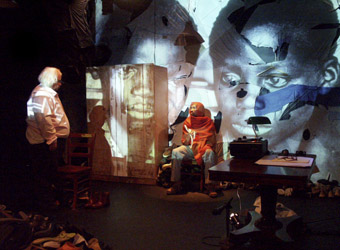partners in crime & reconciliation
urszula dawkins: witness, the blue room, perth

l-r David Moody, Martin Mhando, Witness, Blue Room
photo Serge Tampalini
l-r David Moody, Martin Mhando, Witness, Blue Room
ON A SMALL STAGE CLUTTERED WITH COUNTLESS PAIRS OF OLD SHOES—THE SHOES OF THE DEAD—BETWEEN A COUPLE OF RICKETY WOODEN CHAIRS AND AN IMPOSING, OFFICIAL-LOOKING DESK, TWO MEN PLAY A GAME. ONE, AFRICAN, WIRY AND ENERGETIC, SPINS OR FLIPS A COIN—IT DOESN’T MATTER WHICH—THE RESULT IS ALWAYS HEADS. THE OTHER, WHITE, MASSIVE AND MANIACALLY CONVIVIAL, SEEMS TO BE HIS FRIEND. THE TWO PLAY THE GAME LIKE SPARRING KIDS, LIKE GROWN-UP BROTHERS, LAUGHING TOGETHER MORE INSISTENTLY EVERY TIME THE PREDICTABLE RESULT COMES UP AGAIN—YES, HEADS.
Witness, co-written by award-winning Tanzanian-Australian filmmaker Martin Mhando and WA actor and writer David Moody, explores the law of probability as it plays out in bitter human conflicts, retelling stories of torture and atrocities from Chile to Cambodia in a constantly morphing, fractured form. As the play progresses, the men perform a collage of vignettes in which the roles of white, black, male, female, jailer, prisoner, aggressor and victim are endlessly exchanged. At one point Moody dons a curly black wig to play a comical Colonel Gaddafi; elsewhere both men perform a disturbing Auschwitz cabaret scene as “Hymie and Abe,” complete with Marx Brothers nose-and-glasses.
Produced by newly formed company, Ujamaa—Swahili for ‘collective brotherhood’—Witness is directed and designed by Serge Tampalini, whose shoe-strewn stage is backed by a makeshift projection screen of t-shirt fragments, stretched like overlapping skins. The co-writer-performers and Tampalini are all lecturers at Murdoch University’s School of Social Sciences and Humanities, with lighting and stage management provided by Murdoch students.
Mhando and Moody are joined on stage by actor Lesley-Anne Philps, who as a pointedly well-groomed translator, transcriber and witness observes horrors such as white man Moody repeatedly dunking black man Mhando’s head into a bucket of water, as Mhando attempts to recount the death of a daughter in Rwanda; or the two men telling and retelling their tortures to one another from inside black plastic garbage bags shoved against the piles of rotting shoes. Moody becomes a prisoner, capturing a small bird in his cell—signified by a tiny red satin slipper that he holds delicately with genuinely bruised and welted arms. He delivers a soliloquy that ends with the assertion that “As long as Mandela lives…” But Mandela is dead! laughs Mhando, while the impeccably dressed Philps at her desk smirks at Moody’s wasted passion.
Witness is scripted from several sources including the writings of Tom Stoppard, Athol Fugard, John Kani and Winston Ntshona, and Philip Gourevitch. The bending, morphing and reshaping of narratives produces a sense of anxiety—it’s sometimes hard to follow, but tellingly construes the two men as interchangeable, even placing them at times ‘on the same side.’
The pace and tone of the production are relentless, a barrage of action that might benefit from further development; though, at the same time, audience discomfort serves to highlight the pain of testimony and the legacy of terrors that lies behind the notion of ‘reconciliation.’ At the centre of the work is a scene in which Mhando plays a veiled Antigone, defending her burial of her brother Polynices. Her words seamlessly shift and we realise she’s reciting a section of Noel Pearson’s 2001 address at the Charles Perkins Oration: “On the Human Right to Misery, Mass Incarceration and Early Death.”
The brotherly camaraderie of Mhando and Moody as the play’s alternate antagonists and allies is one of the great strengths of Witness. The opening scene of seeming intimacy and mateship lays a foundation of uncertainty that echoes throughout the ensuing episodes, forcing a constant reassessment of relations between the two.
At times the play’s ever-mounting layers of testament and reframe risk turning to melodrama, as with the scene where Philps holds the collapsed Mhando in her arms, pieta-like, and speaks of “a great Katrina of grief.” The scene is undeniably tender, though, and it is this ability to constantly evince conflicting emotions that seems to propel the play to its ultimate unfolding.
Witness does unfold and seems to end, but takes one last shift to a strikingly coherent scene in which Philps becomes director and Moody and Mhando actors dissecting their own performance with a mix of passion, fire and self-disgust. “Six million people died and we’re doing La Cage aux Folles?,” shouts Moody. “Guilty white liberal and sad black man” confront one another in ‘real life’, until Philps interjects: “He’s the black one, Okay? So he should know!” White man storms off stage. Is he coming back? Black man fishes out his coin and tosses it. “Tails!”, he laughs as he triumphantly exits.
Witness, script, from various sources, by performers Martin Mhando, David Moody, performer Lesley-Anne Philps, director, designer Serge Tampalini, Ujammaa Productions; The Blue Room Theatre, Perth, May 4-22; www.blueroom.org.au
RealTime issue #97 June-July 2010 pg. 35






